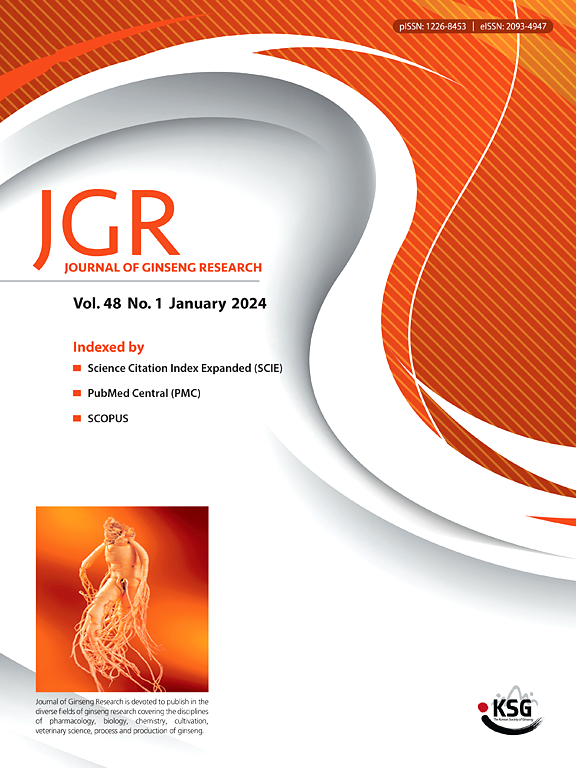Gintonin enhances epithelial barrier function by activating NRF2 pathway in radiation-induced intestinal injury
IF 6.8
2区 医学
Q1 CHEMISTRY, MEDICINAL
引用次数: 0
Abstract
Background
Because the intestine is a radio-sensitive organ in the body, and radiation-induced intestinal injury is a major clinical problem associated with radiotherapy or radiological accidents. Dysfunction of the epithelial barrier leads to bacterial translocation to other organs, resulting in severe inflammation. Recent findings suggest that gintonin (GT) suppresses oxidative stress and inflammation in neuroinflammatory diseases.
Purpose
This study objected to elucidate the mitigating effects of GT on radiation-induced intestinal injury.
Methods
The therapeutic effects of GT were assessed in a mouse model of radiation-induced intestinal injury using histological, immunohistochemical, and real-time PCR. Additionally, the direct effects of GT and NF-E2-related factor 2 (NRF2) activators on radiation-induced epithelial damage were assessed using Caco-2 cell monolayers.
Results
GT treatment reversed radiation-induced body weight loss, attenuated intestinal damage, and inhibited inflammatory response by reducing inflammatory cell infiltration and cytokine expression in the intestines of mice. Additionally, GT treatment activated NRF2 and ameliorated intestinal barrier damage. In vitro experiments showed that GT treatment affected epithelial permeability and intercellular junction expression in Caco-2 cell monolayers under irradiated conditions. Moreover, treatment with NRF2 activator improved epithelial permeability, improved the expression of intercellular junctions in irradiated epithelial cells, and attenuated radiation-induced intestinal injury in a mouse model.
Conclusion
GT maintains epithelial integrity by activating NRF2-mediated antioxidant activity in radiation-induced intestinal epithelial damage of mice. Overall, these results suggest that GT could be a novel therapeutic agent for radiation-induced intestinal damage.

Gintonin通过激活NRF2通路增强辐射诱导肠道损伤的上皮屏障功能
由于肠道是人体对辐射敏感的器官,辐射引起的肠道损伤是与放射治疗或放射事故相关的主要临床问题。上皮屏障功能障碍导致细菌转移到其他器官,导致严重的炎症。最近的研究表明,gintonin (GT)可以抑制神经炎症性疾病的氧化应激和炎症。目的探讨GT对放射性肠损伤的缓解作用。方法采用组织学、免疫组织化学、实时荧光定量PCR等方法,观察GT对小鼠辐射性肠损伤模型的治疗作用。此外,使用Caco-2细胞单层评估了GT和nf - e2相关因子2 (NRF2)激活剂对辐射诱导的上皮损伤的直接影响。结果gt治疗逆转了辐射引起的小鼠体重下降,减轻了肠道损伤,并通过降低肠道炎症细胞浸润和细胞因子表达来抑制炎症反应。此外,GT治疗激活了NRF2并改善了肠屏障损伤。体外实验表明,在辐照条件下,GT处理影响了Caco-2单层细胞的上皮通透性和细胞间连接表达。此外,在小鼠模型中,NRF2激活剂可以改善上皮细胞的通透性,提高辐照上皮细胞细胞间连接的表达,并减轻辐射诱导的肠道损伤。结论在辐射诱导的小鼠肠上皮损伤中,t通过激活nrf2介导的抗氧化活性来维持上皮的完整性。综上所述,这些结果表明GT可能是一种新的治疗放射性肠损伤的药物。
本文章由计算机程序翻译,如有差异,请以英文原文为准。
求助全文
约1分钟内获得全文
求助全文
来源期刊

Journal of Ginseng Research
CHEMISTRY, MEDICINAL-INTEGRATIVE & COMPLEMENTARY MEDICINE
CiteScore
11.40
自引率
9.50%
发文量
111
审稿时长
6-12 weeks
期刊介绍:
Journal of Ginseng Research (JGR) is an official, open access journal of the Korean Society of Ginseng and is the only international journal publishing scholarly reports on ginseng research in the world. The journal is a bimonthly peer-reviewed publication featuring high-quality studies related to basic, pre-clinical, and clinical researches on ginseng to reflect recent progresses in ginseng research.
JGR publishes papers, either experimental or theoretical, that advance our understanding of ginseng science, including plant sciences, biology, chemistry, pharmacology, toxicology, pharmacokinetics, veterinary medicine, biochemistry, manufacture, and clinical study of ginseng since 1976. It also includes the new paradigm of integrative research, covering alternative medicinal approaches. Article types considered for publication include review articles, original research articles, and brief reports.
JGR helps researchers to understand mechanisms for traditional efficacy of ginseng and to put their clinical evidence together. It provides balanced information on basic science and clinical applications to researchers, manufacturers, practitioners, teachers, scholars, and medical doctors.
 求助内容:
求助内容: 应助结果提醒方式:
应助结果提醒方式:


